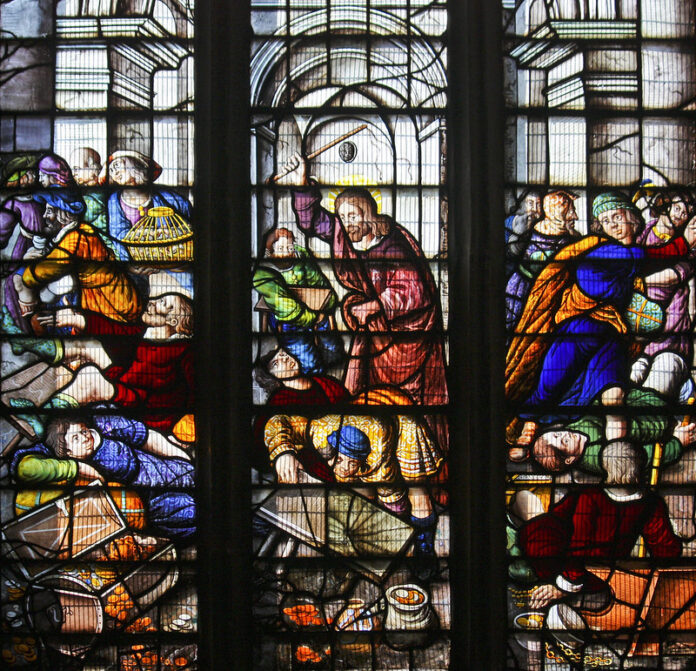Readings: Exodus 20:1-17; 1 Corinthians 1:22-25; John 2:13-25
Theme: ‘A House of Prayer for all Peoples’ (Isaiah 56:7)
A few days ago, I came across a recent interview with the young American poet, Amanda Gorman, that shocked me. In the course of the interview she mentioned that the poem she had recited to great acclaim during Joe Biden Presidential inauguration in January 2021 (The Hill We Climb), had been removed from elementary school libraries in Florida. A single parent had complained that some words in the poem might fuel hatred and lead to violence. The offending lines were: ‘We’ve braved the belly of the beast,/ we’ve learned that quiet isn’t always peace/ and the norms and notions of what just is, isn’t always justice’.
The truth of Amanda Gorman’s words is clearly evident in the life and ministry of Jesus. He was certainly a prophet of peace and justice, but he knew that the justice of God did not mean remaining ‘quiet’, and accepting what ‘just is’. His passion for God’s Kingdom led him to brave ‘the belly of the beast’ and confront those who used their power to oppress rather than liberate. In today’s gospel, we see his passion turning to anger when he observes the temple of Jerusalem, his Father’s House, being desecrated. This sacred place, this place of prayer, had been turned into ‘a market’ (Jn 2:13), or ‘a den of thieves’ (Lk 19:46). So, as today’s gospel reading tells us, Jesus makes a whip of cord and drives out the merchants, along with their cattle and sheep. He overturns the tables of the money-changers and scatters their coins on the ground. Then he tells the pigeons sellers to take their pigeons away with them (Jn 2: 14-15). What made Jesus so angry on this occasion? True, he was often angry and frustrated with the Scribes and Pharisees, but this is the only time we see his anger turning to violent action.
To understand Jesus’ anger we need to realise the importance of the Temple for the Jews. The first Temple of Jerusalem was built by King Solomon in the tenth century BC to house the Ark of the Covenant, the residence of God on earth. Sacked and destroyed a few decades later, a second Temple was built in the sixth century BC. In 63 BC, this new Temple was ransacked but not destroyed by the Romans. In 19 BC it was completely renovated and expanded by King Herod the Great. Today’s gospel tells us that the new temple took forty-six years to complete. At the time of Jesus, it was a magnificent building of which the Jews were justly proud. It was the centre of their religious, social and also commercial life. Indeed, the temple played a significant role in the life of Jesus from his earliest years. His parents were accustomed to travel to Jerusalem every year for the feast of the Passover. When he was twelve years old, much to the consternation of his parents, Jesus remained in the temple for three days, listening to the doctors of the Law, and asking them questions (Lk 2:41-42). According to John’s gospel, it was Jesus’ custom to go to the temple at regular intervals, for the Feasts of the Passover, the Tabernacles, and the Dedication of the Temple.
Jesus, then, did not hate the Temple, nor did he hate Jerusalem. Luke tells that he wept over the Holy City, foreseeing its destruction by the Romans in 70AD. His anger was directed, not against the temple, but against the powerful Temple authorities, the priests, who had turned temple worship into a lucrative business for themselves. They controlled the buying and selling of the animals for sacrifice, the exchange of currency, and the collecting of the temple tax, equivalent to half a week’s wages of the average labourer. In effect the pilgrims, and especially the poor, were being fleeced to line the pockets of the wealthy priests. Moreover, the buying and selling of animals and the exchange of money took place in the courtyard of the gentiles. This meant that they (the gentiles) could not pray in peace. No wonder Jesus was furious. So, in open defiance of the temple authorities, he resorted to an action that surely sealed his fate.
The temple, the House of God, was no longer ‘a house of prayer for all peoples’ (Is 56:7), but a place of empty rituals and corrupt practices. Its worship had become commercialised and hypocritical, not the kind of worship that pleases God. What Jesus wanted, and this remains his challenge to us today, is ‘worship in spirit and in truth’ (Jn 4.23) – the heartfelt worship of lives marked by integrity and justice, compassion and service of others. And Jesus didn’t just tell us how to worship God. He modelled true worship for us by his life of self-giving love and by his sacrificial death on the Cross. He has become the new Temple of God. I will end with a popular prayer, composed by Bishop Thomas Ken (1637-1711), and inscribed over the door of St Stephen’s Church, Walbrook, London:
O God, make the door of this house
wide enough to receive all who need human love and fellowship,
and a heavenly Father’s care;
and narrow enough to shut out all envy, pride and hate.
Make its threshold smooth enough to be no stumbling block to children,
nor to straying feet,
but rugged enough to turn back the tempter’s power:
make it a gateway to thine eternal kingdom. Amen
Fr Michael McCabe SMA
To listen to an alternative Homily for this Sunday, from Fr Tom Casey of the SMA Media Centre, Ndola, Zambia please click on the play button below.
|
|

